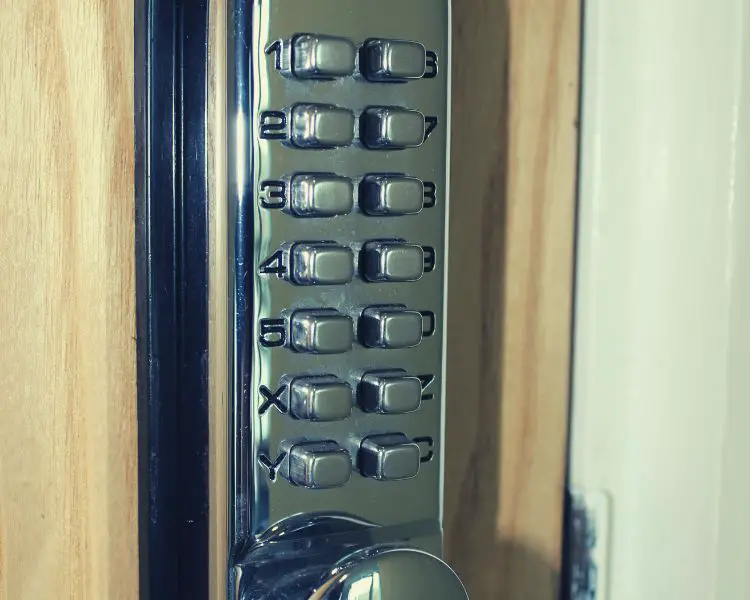When it comes to electronic and mechanical keypad door locks, each type has its own benefits. While electronic models are easily reprogrammable and work with multiple codes, they are susceptible to hacking. On the other hand, mechanical models are more secure, making them harder to crack!
To crack a mechanical keypad door lock, you must assess the lock itself to determine how it operates. If cracking the lock is unsuccessful, homeowners can try changing the lock’s combination or bypassing it to unlock the door. Locksmiths can repair or replace faulty mechanical keypad locks.
In this article, we’re going to discuss everything you should know about cracking a mechanical keypad door lock. Then, once we’ve explained why it’s often difficult to crack these specific keypad locks, we’ll outline the steps that should be followed to crack them!
Can You Crack A Mechanical Keypad Door Lock?

Unlike traditional locks, most smart ones do not use a simple key and tumbler design. While modern smart locks may have a physical backup key that can be used to unlock the door, these locks typically utilize sophisticated technology to operate the lock. While there are many types of smart locks, keypad locks are among the most popular.
Also known as combination locks, keypad locks allow you to program a code or combination that will unlock the door where it is installed. Typically, this code will consist of numbers and letters and must be punched into the keypad to open the door.
It’s crucial to note that there are two main types of keypad locks. Electronic keypad locks offer smart functionality; these locks are easily reprogrammable and can operate with multiple access codes. Most electronic models only allow a few attempts before it temporarily blocks further attempts to unlock the door.
Mechanical keypad door locks, despite their appearance, function more like traditional door locks than smart locks. Unlike electronic keypad locks, mechanical models are programmed to unlock with one access code. These mechanical keypad locks can withstand repeated use and harsh weather conditions.
However, it may be harder to crack a mechanical keypad lock if you get locked out of your house. With electronic models, you can program a new access code from your smartphone. Unfortunately, this same convenience isn’t available for mechanical keypad locks due to purely mechanical components.
If you need to crack a mechanical keypad door lock, there’s a way to do this! Unfortunately, due to the varying mechanics used in these locks, it is not always possible to crack a mechanical keypad lock on your own. But, of course, this is a testament to the overall safety provided by these mechanical locks.
If you’re unsuccessful in cracking your lock yourself, you may need to bypass the lock or hire a professional locksmith.
Read on as we explain the process of cracking a mechanical keypad door lock!
How To Crack A Mechanical Keypad Door Lock In 7 Steps?
Both electronic and mechanical keypad locks use an access code to lock and unlock doors. With electronic models, it’s possible to reprogram your lock from your smartphone. With mechanical models, this is not possible due to the purely mechanical components inside the lock. However, with a bit of patience, it’s possible to crack a mechanical keypad lock!
Step One: Assess The Keypad Of Your Mechanical Door Lock
If you want to crack a mechanical keypad door lock, the first step is to assess the exterior of your lock, specifically the keypad. Depending on how often you change the combination of your mechanical lock, the keypad may be able to reveal which buttons are commonly used. Essentially, you should assess your keypad for wear and tear on the buttons.
The buttons that seem the most worn are likely used more often than the others, meaning they’re likely used in the combination for your lock. You should write these numbers and letters down. You could also mark the numbers with tape. Taking note of any keypad buttons that fit this worn-out description will come in handy in cracking the lock’s code.
Step Two: Try Entering Your Keypad Combination
If you remember the code that’s supposed to unlock your mechanical keypad lock, you should try entering this. If this code doesn’t work, the lock may be damaged, which we’ll address in the following step. However, if you can’t remember the code, you should try using a combination of the numbers and letters that were more worn out on the keypad.
Of course, we marked these buttons in the previous step. This code will be comprised of either 4 or 5 alphanumeric characters. Try entering these buttons in different orders. Taking note of which combinations you’ve tried will be useful here. Due to the mechanical design of the keypad lock, you won’t be blocked after unsuccessful attempts.
Step Three: Determine If Mechanical Door Lock Is Damaged
If you’ve been unable to crack the code of your mechanical keypad lock, the lock itself may be damaged. While these mechanical locks are typically more resistant to repeated use and harsh weather, they can become damaged and faulty after a few years.
If you don’t think your lock is damaged, you can attempt using a physical backup key to change the mechanical keypad lock’s combination. While this will vary between different models, we’ll outline how this is typically done in Step Four and Step Five.
If your lock is damaged, you could proceed to Step Six and attempt to bypass your mechanical keypad lock physically. Doing this should unlock the door where the lock is installed. Alternatively, you could proceed to Step Seven and repair or replace your mechanical keypad lock.
Step Four: Look For A Physical Backup Keyhole
If you were not able to crack the code of your mechanical keypad lock, you should look for a physical backup keyhole. Depending on the manufacturer and model of your keypad lock, this backup key may allow you to unlock the door. With some mechanical keypad locks, this key is used to change the code, which we’ll address in the following step.
Step Five: Change Your Mechanical Lock’s Combination
If your mechanical keypad lock is not damaged, changing the combination may fix the issues you’re experiencing. Ultimately, the process of changing the combination of your keypad lock will depend on the brand and model of your lock. For the best results, you should consult the user’s manual that your lock’s manufacturer provided.
If you can’t access a copy of this owner’s manual, you could physically bypass the lock to access it, which we’ll outline in the next step. However, if you want to try changing the code without the manual’s instructions, you can follow the steps outlined in the following YouTube video!
Step Six: Bypass Your Mechanical Keypad Lock
If you’re unable to crack your mechanical keypad’s code or change the combination, you may need to bypass the lock itself. There are two handy methods you can use to bypass the lock!
Method #1
The first method for bypassing a keypad lock involves removing the keypad from the door. By removing the keypad, you should be able to access the inner components to unlock your door. If you remove the keypad to unlock your door using this method, you should proceed to have your locks repaired or replaced. Ultimately, this method will vary according to the model and manufacturer of your lock.
Method #2
If you don’t want to remove the keypad itself, it’s possible to bypass a lock using a drill and a pick tool. Essentially, you’ll need to drill a small hole where the lock mechanism is located. For most mechanical keypad locks, the mechanism is located at the bottom of the lock.
Once the small hole has been drilled below the keypad, the lock-picking tool can be inserted through the hole. The pick should be used to locate the locking mechanism. Once you’ve located the locking mechanism, you’ll be able to push the pick downward. The door should now open.
If you’re unable to unlock the door at first, try picking the lock again. It may take a few minutes to locate the locking mechanism. If you’re still unsuccessful, it might be time to call a locksmith for help!
Step Seven: Repair Or Replace Your Mechanical Keypad Lock
If you’re unable to crack or bypass a mechanical keypad lock, you should call a locksmith. A professional service will not only be able to crack your lock, but they can repair or replace it!
Conclusion
To successfully crack a mechanical keypad door lock, homeowners need to assess the keypad and lock itself. Assessing the keypad may reveal which buttons are typically used to unlock the door, while examining the overall lock may reveal whether it has been damaged. For some people, changing the lock’s combination may fix the issue with the keypad lock.
For other people, however, it may be necessary to physically bypass the lock – luckily, there’s more than one way to do this! However, if you don’t have the appropriate tools to bypass the lock, you may need to call a locksmith service to replace or repair your mechanical keypad door lock.
